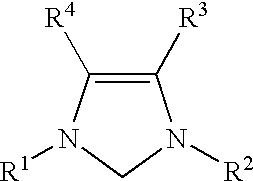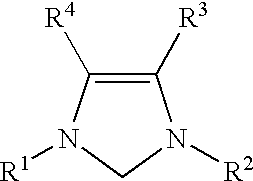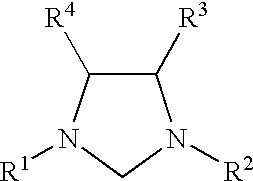Catalyzed coupling reactions of aryl halides with silanes
- Summary
- Abstract
- Description
- Claims
- Application Information
AI Technical Summary
Benefits of technology
Problems solved by technology
Method used
Image
Examples
example 1
2,6-Diisopropylaniline (100 g, 0.56 mol), glyoxal (31.5 mL, 40% in water, 0.28 mol), and absolute ethanol (500 mL) were charged to a round-bottom flask. A few drops of formic acid were added, and the solution immediately changed from colorless to yellow. After a few hours, a yellow precipitate appeared. The reaction mixture was stirred for another two days. The yellow precipitate was collected by filtration and washed with cold methanol. 1,4-Bis(2,6-diisopropylphenyl)diazabutadiene was obtained in the amount of 81.74 g, a yield of 77.5%.
Toluene (500 mL) and 1,4-Bis(2,6-diisopropylphenyl)diazabutadiene (25 g, 66 mol) were added to a reaction vessel, followed by solid paraformaldehyde (2.0 g, 66 mmol). The reaction mixture was heated to 100.degree. C. until most of the paraformaldehyde had dissolved. The mixture was then cooled to 40.degree. C., and HCl (16.5 mL, 4 moles per liter in dioxane, 66 mmol) was added via syringe. The reaction mixture turned brown in color, and a white preci...
example 2
For each run, a screw-capped vial with a septum was charged with palladium acetate (6.7 mg, 0.03 mmol), 1,3-bis(2,6-diisopropylphenyl)imidazolinium chloride (13 mg, 0.03 mmol), (nBu).sub.4 NF (2 mL of a 1.0M solution in tetrahydrofuran, 2.00 mmol), and a magnetic stirring bar. 1,4-dioxane (3 mL), aryl halide (1.0 mmol), and phenyltrimethoxysilane (2.0 mmol) were added in turn to the vial. The vial was placed in a 80.degree. C. oil bath and the mixture was stirred for a number of hours. The mixture was then allowed to cool to room temperature. The reaction mixture was quenched with water (30 mL), and extracted with diethyl ether (4.times.30 mL):. The combined diethyl ether extractions were dried over MgSO.sub.4, concentrated in vacuo, and purified by flash chromatography.
Some homocoupled product was formed when 4-bromotoluene was used in this reaction. When 4-bromotoluene was reacted at 60.degree. C. with 3 mmol of phenyltrimethoxysilane, the amount of homocoupled product formed was ...
example 3
Reagents, analyses, and procedures were as described in Example 2, except that two heteroaryl halides were used. The heteroaryl halides and reaction times for each run are listed in Table 2. All of the yields reported in Table 2 are of the heterocoupling product.
PUM
| Property | Measurement | Unit |
|---|---|---|
| Angle | aaaaa | aaaaa |
| Angle | aaaaa | aaaaa |
| Temperature | aaaaa | aaaaa |
Abstract
Description
Claims
Application Information
 Login to View More
Login to View More - R&D
- Intellectual Property
- Life Sciences
- Materials
- Tech Scout
- Unparalleled Data Quality
- Higher Quality Content
- 60% Fewer Hallucinations
Browse by: Latest US Patents, China's latest patents, Technical Efficacy Thesaurus, Application Domain, Technology Topic, Popular Technical Reports.
© 2025 PatSnap. All rights reserved.Legal|Privacy policy|Modern Slavery Act Transparency Statement|Sitemap|About US| Contact US: help@patsnap.com



